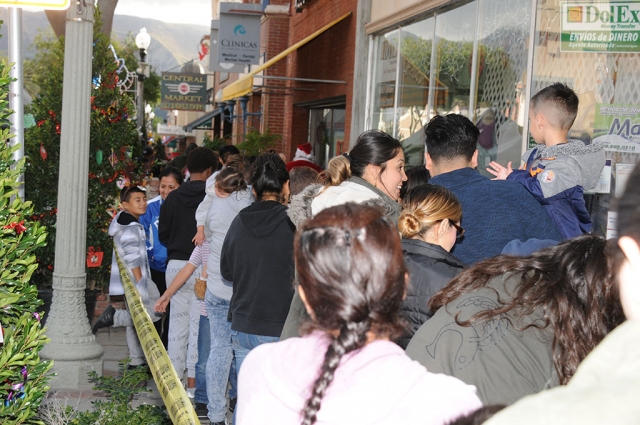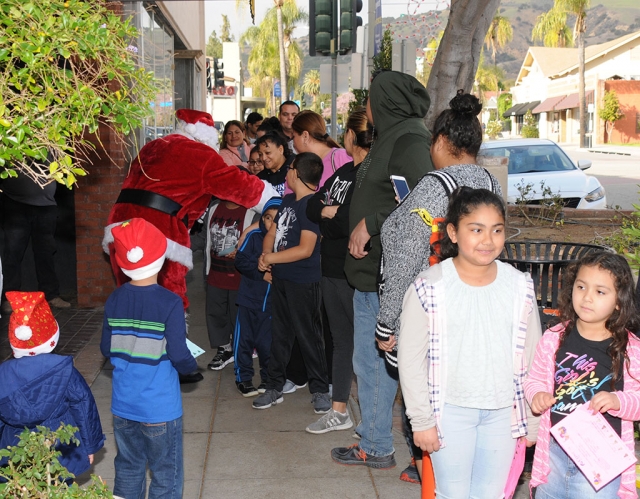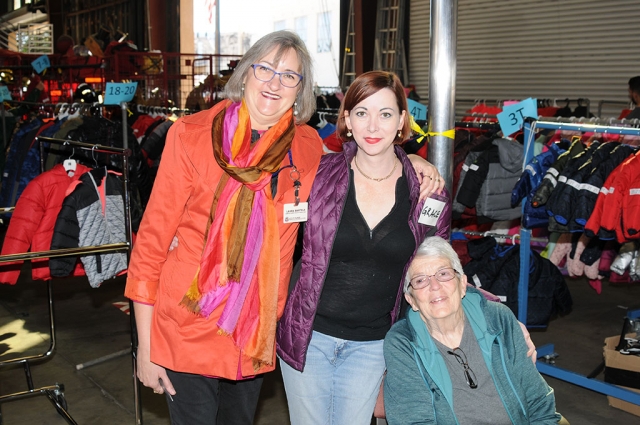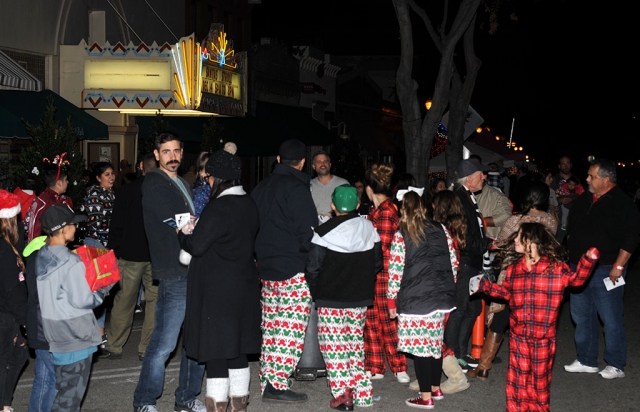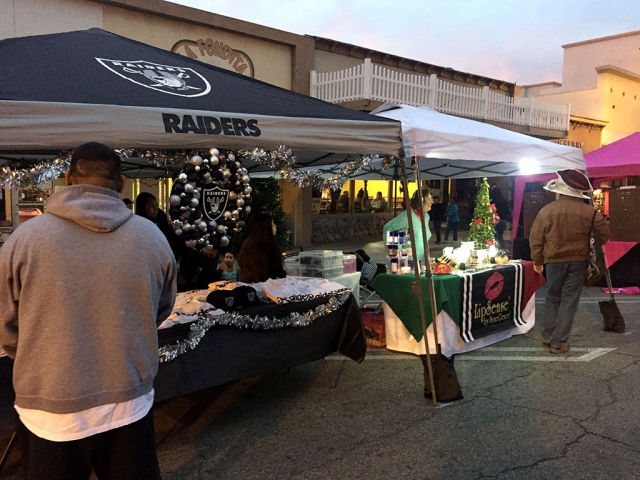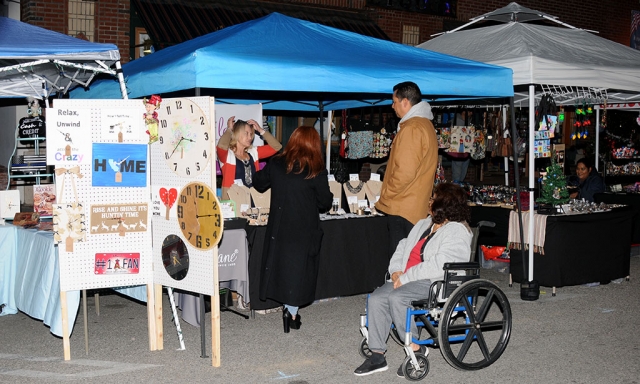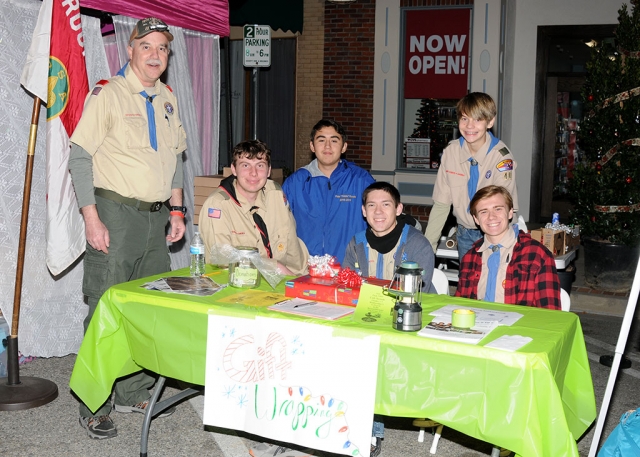|
By Anonymous — Wednesday, December 26th, 2018
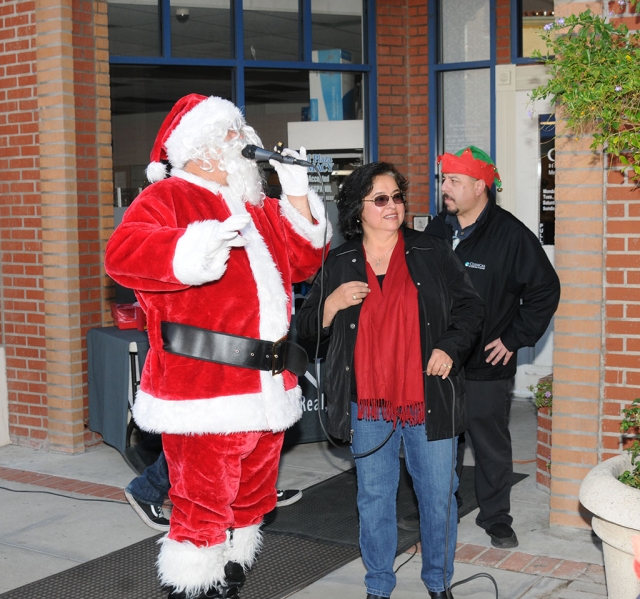 On Monday, December 17th Santa Claus made a special appearance at Clinica’s, located on Central Avenue in Fillmore. Children and their parents lined down the street to meet and take pictures with Santa. Enlarge Photo |
 Photo of the Week "Gorgeous pink rose from my rose garden." by Bob Crum. Photo data: Canon 7DMKII, ISO 100, shutter speed 1/200th of a second,Tamron 16-300mm lens @32mm, aperture f/4.0. Enlarge Photo By Bob Crum — Wednesday, December 26th, 2018
Happy New Year!
It's that time again. New Year's resolutions! I'm on it. 1. Make a budget and stick to it. Yep, that'll work if my computer is forbidden to visit amazon.com. 2. Forgive myself and move on from past mistakes. You know, I once thought I made a mistake, but it was only a thought. 3. Take a frequent break from all screens. Stop watching reruns of The Little Mermaid on the telly. Forget it! 4) Drink more water. Oh sure, and have to pee every 30 minutes. 5) Stop hitting the snooze button. Impossible! Let's simplify: Save money, enjoy life, drink less, take a trip, lose weight, help others, find love, get fit. Do these make and break resolutions sound familiar? How soon do you break them? January 3rd? With a smidgen of willpower maybe January 10th. Well, you tried. Enough. Here's my one, authentic, genuine resolution for January 1: I hereby resolve not to make any stupid New Year's resolutions. There! That's specific, measurable, attainable realistic and relevant. Sweet success is assured. How many will join me in this resolution revolution? Forget the gym... pass the eggnog! Photographically speaking, I've been considering Project 365, shooting at least one photo every day for the coming year... 365 photos by next Jan 1. Perhaps just photos made only in and around Fillmore. Anyone else interested in this project? If enough Fillmore photographers express an interest, I'll set up a Facebook page to add photos from participants. Your thoughts? Speaking of photos, Santa left you a new camera, right? After reading the manual, you commenced photoing the Christmas festivities with jolly abandon. I am so proud of you! Now, what to do with all those precious photos? Digital images floating around Facebook, Twitter, Instagram, etc. are fleeting at best. Worse, technology constantly evolves making all the so-called digital social platforms unstable and risky. There's no guarantee your digital photos will be up on the Internet five years hence. A photo book/album is an excellent alternative and sure to become a family heirloom. Offload your best photos from your flash card or smartphone to a folder on your computer. From there, upload to a photo book/album printer. What's more, the tactile feel of the pages of a photo book/album full of precious memories is an indescribably pleasurable experience. Enough said? As promised, the following is a partial list of photo book/album printers. Prices vary because of options. User friendliness varies. Persevere. Check the printer's website for details. The following are some of the most popular photo book printers: Costco Photo Centers, https://www.costcophotocenter.com/ProductDetails/Photobooks. I have had a photo book printed by Costco picked up at Oxnard and was very pleased. Another printer is Adorama Pix: https://www.adoramapix.com/app/products/photo-books. Mixbook is relatively new but already known for quality with lots of options and simple to use... https://www.mixbook.com/photo-books. A very popular quality photo book printer is Snapfish. Lots of templates and Snapfish actually guides you through the process. A standby printer is the classic Shutterfly. Lots of add-ons and plenty of options for a beautiful photo book... https://www.shutterfly.com/photo-books. Another great printer is Amazon Prints, great pricing, a trustworthy brand, easy to use... https://www.amazon.com/Amazon-Prints/b?ie=UTF8&node=14866317011. Last but not least, Nations Photo Lab. At their website, they discuss the difference between a photo book and a photo album. Worth the read, here... https://nationsphotolab.zendesk.com/hc/en-us/articles/360006144354-Top-8.... Go online to cut & paste. Persevere! Happy booking! Photo of the week is a gorgeous rose to ring in the New Year with beauty. My trained insect on the flower assures focus. His name is Bug. Send questions, comments and/or suggestions to: focusonphotography@earthlink.net |
Now Hiring: Deputy City Clerk
The City of Fillmore is seeking a detail-oriented and highly organized professional to join our City Clerk’s Office as Deputy City Clerk. This key role supports City Council operations, maintains official records, ensures legal compliance, and helps uphold transparency in local government. If you’re passionate about public service, governance, and supporting elected officials, we encourage you to apply. Learn more and apply at www.fillmoreca.gov.
|
By Anonymous — Wednesday, December 19th, 2018
 On Saturday, December 15th at Fillmore Station 91 the Fillmore Fire Department and the Santa Clara Valley Legal Aid hosted their Annual Toy & Coat Giveaway. This year from 9am to 12pm they were able to provide over 650 kids with toys, books, coats, food and more. Enlarge Photo |
|
By Anonymous — Wednesday, December 19th, 2018
 Friday night’s Santa Stroll down Central Avenue offered food, crafts, a tamale contest, and a chance to tell Santa Claus what you wanted for Christmas. Heather, Luke and Jenna did just that inside the Towne Theatre. On the naughty & nice scale, the siblings ranked ‘nice’. Enlarge Photo |
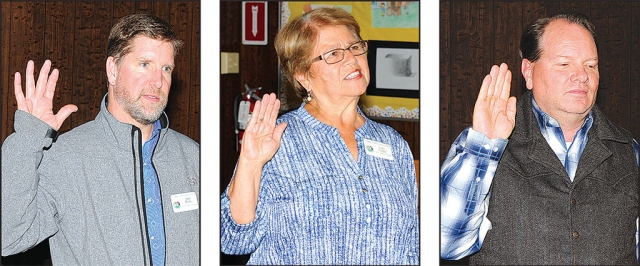 Re-elected FUSD board members were sworn in at last night’s board meeting. (l-r) Returning to the board were Sean Morris, Lucy Rangel, and Scott Beylik. Enlarge Photo By Anonymous — Wednesday, December 19th, 2018
Annual Organizational Meeting of the Board of Education: Election of Officers Presentation and Approval of Single Plans for Student Achievement Board Policy Updates (Second Reading) Approve License Agreement with Gourmet Specialties, Inc. Personnel Recommendations |
|
By Anonymous — Wednesday, December 19th, 2018
 Air Force Pilot and Flight Instructor Chris Gurrola has been promoted to Major. Joining Chris at the Promotion Ceremony in Columbus, Mississippi, were his wife Cassie, and their four children, Luciana, Joaquin, Annelise and Viviana, as well as his parents, Tim and Amy Gurrola. Chris graduated from Fillmore High School in 2005, then attended college at the United States Air Force Academy, where he earned a B.S. in Mechanical Engineering. Congratulations to Major Gurrola! Enlarge Photo |
|
By Ventura County District Attorneys Office — Wednesday, December 19th, 2018
Fillmore Man Sentenced for First-Degree Murder in Vehicular Killing
District Attorney Gregory D. Totten announced today that Eduardo Robles (DOB 10/29/87), of Fillmore, was sentenced to 34 years to life in prison by Judge Ryan Wright. On October 22, 2018, Robles was convicted of first-degree murder of motorist Benjamin Brown and attempted murder of his passenger Jose Gaspar. On May 31, 2018, Robles was driving his vehicle on Highway 126 when he intentionally rammed the car in front of him, which was being driven by Mr. Brown, in a premeditated attempt to kill his passenger, Mr. Gaspar. The impact of the collision caused Mr. Brown’s vehicle to veer across the highway and collide with a tractor-trailer. This sentencing, as well as Robles’ convictions, followed a jury trial that lasted several weeks and included testimony by numerous witnesses concerning the crash scene, the death of Mr. Brown, the injuries to Mr. Gaspar, and Robles’ own statements about his intent to kill using his vehicle. The prosecution of this case was based upon an extensive investigation by the Ventura County Sheriff’s Office, the Ventura Police Department and Simi Valley Police Department. The Ventura County District Attorney’s Office is the public prosecutor for the county’s 850,000 residents. The office employs approximately 280 employees including attorneys, investigators, victim advocates, and other professional support staff who strive to seek justice, ensure public safety, and protect the rights of crime victims. |
|
By Anonymous — Wednesday, December 19th, 2018
Early Versions of the Bill Would Have Expanded Commercial Logging in Los Padres National Forest and Other Public Lands
Submitted by Rebecca August, Public Lands Advocate, Los Padres ForestWatch After months of contention over conservation, food assistance, and forestry provisions, Congress yesterday passed a final version of the Farm Bill. Several loopholes that appeared in early versions of the bill would have facilitated massive commercial logging across national forests with minimal environmental review and public input. Typically reauthorized every four to five years, the Farm Bill directs agricultural programs like subsidies to farmers, food stamps, rural development, and research and marketing. Other programs managed by the Department of Agriculture, such as National Forests, are also included in the bill. Tucked away in the House version of the Farm Bill, passed in June of this year, were multiple provisions that would have fast-tracked logging and other development in forests throughout the country, including Los Padres National Forest. The Senate passed their own version of the bill containing none of these provisions. The House bill’s hidden riders would have fast-tracked landscape-scale logging projects up to 10 square miles in size, enabling tens of thousands of acres National Forests to be logged. The bill would have permitted bulldozing new roads up to three miles long in pristine roadless areas, removed restrictions on aerial spraying of herbicides that could pollute waterways and harm pollinators, and encouraged the Forest Service to ignore federal wildlife experts, disregarding decades of established development procedure. The forestry provisions became a major point of disagreement as the two versions of the legislation were reconciled in conference committee, aggravated by White House tweets about forest management and raking. Ultimately, the House riders that would have affected the Los Padres National Forest — where the Trump Administration is currently fast-tracking two large commercial logging projects — were left out of the final 807-page bill after intense public pressure brought on by conservation organizations such as Los Padres ForestWatch. Hundreds of residents throughout the central coast region wrote their members of Congress to demand that the forest loopholes be removed from the Farm Bill. “This year, the House launched an unprecedented effort to undermine bedrock environmental laws that have been on the books for decades to protect our forests and encourage robust public input,” said Los Padres ForestWatch Public Lands Advocate Rebecca August. “We will continue to monitor new legislation that could negatively impact local public lands, and work with local congressional representatives to protect the Los Padres National Forest.” All four Congressmembers whose districts cover the Los Padres National Forest voted in favor of the final version of the Farm Bill. Congressmembers Salud Carbajal (D-24), Julia Brownley (D-26), and Jimmy Panetta (D-20), voted against the House version’s forestry loopholes. Congressman Kevin McCarthy (R-23) voted in favor of the logging provisions. About Los Padres ForestWatch |
 Photo of the Week "Boat #22, Girlie Girl in the Ventura Harbor boat parade" by Bob Crum. Photo data: Canon 7DMKII camera, ISO 12800, Tamron 16-300mm lens @35mm, f/4.5, shutter speed 1/250 seconds. Enlarge Photo By Bob Crum — Wednesday, December 19th, 2018
Merry Christmas!
Let's suppose for just a moment that you are fed up with your sedentary lifestyle... wasting away watching Netflix? Reruns of Friends put you to sleep? Ready to put some adventure in your life? Hark, photography will enrich your life in ways you can't even imagine. Just sayin'. After a breathing treatment last Saturday, I elected to view the Parade of Lights at Ventura Harbor. I arrived an hour early this time hoping to find a parking space quickly. I knew which dock I wanted to shoot from so I turned into Parking Area 1. Whoa! A mirage? Right in front of me, a pickup was pulling out of a parking space. I parked without having to create a parking space. Imagine that! Gear in hand, I slowly walked over to the nearby dock. The dock is positioned at the far east end of the harbor, where I anticipated the boats would make a 180° turn offering several perspectives. While there were several hundred spectators spread out across the promenade above, I was surprised that no one was on the dock. Could I be so lucky as to have the whole dock to myself? Wishful thinking! I locked the camera onto the ball head on my tripod at the end of the pier. As I was busy taking a few practice shots, I heard him: “YOU CAN'T ARREST ME... I HAVEN'T DONE IT!” He slowly staggered towards me. I became concerned about what might happen. As he approached, he reached for my camera. I knocked his arm down. He staggered back and it happened... SPLASH! Even before I knelt to help assist him back onto the dock, help was rapidly approaching. Harbor employees, hearing the splash, came running down the pier and promptly pulled the boozer back up onto the dock. Once on the dock, they wasted no time whisking him away. Excitement aplenty! As the start time drew nigh, I felt the dock wiggle. Looking back, I saw a large group approaching. They finally stopped about 10 feet away. Fine Christmas carolers all but I did not appreciate their dancing and prancing. As the dock heaved up and down, I grabbed the tripod and hung on. Thank goodness they settled down as the parade began. As anticipated, my location was perfect. But, as y'all now know, nighttime photography is wrought with conundrums. But this time I brought my tripod. Why? To stabilize the camera when shooting at slower shutter speeds. If I can slow the shutter speed, when appropriate, it will allow a lower ISO. A lower ISO means less noise in the digital image. Less digital noise means less work in post-processing. It helped somewhat. But there's a limit to how slow the shutter speed can go and not get motion blur of the subject. Because every boat moved at different speeds, and lit differently, every shot had to be quickly evaluated and settings adjusted. Another great stimulating learning experience. Gotta love photography! I'm pleased with the photos I made with the tripod although the parade was underwhelming. C'est la vie. Photographers, and phonetographers, be READY! Batteries (phone) fully charged? Uncountable photo ops Christmas morning. Note: Facial expressions, jumps of joy, are spontaneous and fleeting. Miss them and they're gone forever! BE READY! It's counter-intuitive but don't get involved in the happening in front of you until after you've got the shot. Then hoot & holler. Again: Make the photo then celebrate! Afterward, consider a Christmas album of awesome photos! I'll discuss photo albums next time. In the meantime, make awesome holiday photos!!! To you and yours, with love and gratitude, I sincerely wish y'all a very Merry Christmas and Happy Holidays! Send comments, questions and/or suggestions to: focusonphotography@earthlink.net |
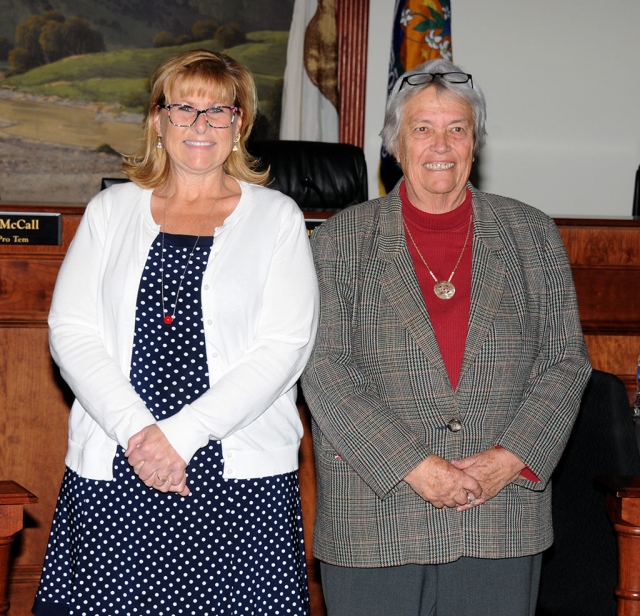 At last night City Council meeting Diane McCall (left) & Lynn Edmunds (right) took their Oath to Office as the new members of the Fillmore City Council. Enlarge Photo By Anonymous — Wednesday, December 12th, 2018
The Oath of Office was administered to Lynn Edmonds, Fillmore's new City Council Woman. Certificates of Election were also presented to Edmonds and Diane McCall. McCall took second place and will return to her seat on the Council. Incumbent Carrie Broggie will not be returning to the Council. According to the Ventura Star, "Edmonds raised far more than her competitors. .... Edmonds also got money from political committees of two unions: the Southern California District Council of Laborers and the AFL-CIO. And she received contributions and endorsements from the Ventura County Democratic Central Committee and the Santa Clara Valley Democratic Club." (Tony Biasotti, Ventura County Star). Neither Diane McCall nor Carrie Broggie sought money outside. Fillmore Mayor Manuel Minjares praised Carrie Broggie for her exceptional work on the Council. This marks the first time in Fillmore election history that outside political parties and associates contributed significant money to the Council race. |


